Artificial Neural Networks for Modelling and Predicting Urban Air Pollutants: Case of Lithuania
Abstract
1. Introduction
- How did air quality change in Vilnius Old Town after the introduction of loop traffic by Vilnius city municipality compared the recorded amounts of pollutants in July 2019 and in July 2020?
- Did loop traffic solve air quality problems in Vilnius Old Town, or it is still important to search for options for a better and environmentally friendly transport network?
- What can be suggested as the priority areas for further research into Vilnius Old Town air quality in the context of transport traffic change regulations?
2. Ambient Air Quality Evaluation
3. Research Methodology
3.1. Research Area
3.2. Data Collection
3.3. Data Analysis and Mathematical Modelling
4. Results
4.1. Preliminary Analysis for Vilnius Agglomeration
4.2. Air Pollution Analysis Results in the Vilnius Old Town after Loop Traffic Agreement
4.3. Inferential Statistical Analysis Results
Results of Case Processing
5. Discussion and Limitations
6. Conclusions
Supplementary Materials
Author Contributions
Funding
Institutional Review Board Statement
Informed Consent Statement
Data Availability Statement
Conflicts of Interest
Appendix A
| 1 Station | Station Type | Station Coordinates | Description |
|---|---|---|---|
| Vilnius, Old Town | city background | N 54°40′53″ E 25°17′17″ | Located in a densely populated, crowded area, near a low-traffic street. |
| Vilnius, Lazdynai | city background | N 54°41′8″ E 25°12′39″ | Located in a residential area, away from streets and other sources of pollution. |
| Vilnius, Žirmūnai | transport | N 54°42′55″ E 25°17′22″ | Located close to heavy traffic on Kareivių Street, near the intersection with Kalvarijų Street. |
| Vilnius, Savanorių Avenue | industrial | N 54°40′24″ E 25°14′56″ | Located on a busy street, but at a greater distance from it, in a square next to residential houses. Air quality in this area can be significantly affected by emissions from both transport and the nearby industrial and energy companies in Žemieji Paneriai. |
| Station | PM10 µg/m3 | PM2.5 µg/m3 | SO2 µg/m3 | NO2 mg/m3 | O3 µg/m3 | CO mg/m3 | C6H6 µg/m3 | |||||||||
|---|---|---|---|---|---|---|---|---|---|---|---|---|---|---|---|---|
| Cvid | Cmax 24 h | P | Cvid | Cvid | Cmax 24 h | Cmax 1 h | Cvid | Cmax 1 h | V | Cmax 8 h | P1 | P2 | Cmax 1 h | Cmax 8 h | Cvid | |
| 2020 Existing Standards, Limit Values, Information and Alert Thresholds for the Protection of Human Health | ||||||||||||||||
| 40 | 50 | 35 d. | 20 | 125 | 350 | 40 | 200 | 18 | 120 (1) | 25 | ||||||
| Vilnius Old Town | 24 | 155 | 10 | 5.9 | 9.5 | 13.3 | 15 | 109 | 0 | 1.4 | ||||||
| Vilnius, Lazdynai | 25 | 149 | 6 | 10.1 | 15.0 | 22.6 | 11 | 95 | 0 | 117 | 0 | 3 | 124 | |||
| Vilnius, Žirmūnai | 27 | 152 | 16 | 13.6 | 25 | 123 | 0 | 117 | 0 | 2 | 127 | 0.9 | 0.23 * | |||
| Vilnius, Savanorių Avenue | 13 | 140 | 6 | 5.0 | 10.0 | 38.6 | 14 | 87 | 0 | 1.2 | 0.38 * | |||||
| 2019 existing standards, limit values, information and alert thresholds for the protection of human health | ||||||||||||||||
| Station | 40 | 50 | 35 d. | 20 | 125 | 350 | 40 | 200 | 18 | 120 (1) | 25 | |||||
| Vilnius Old Town | 26 | 87 | 10 | 5.8 | 8.9 | 43.9 | 18 | 104 | 0 | 2.1 | ||||||
| Vilnius, Lazdynai | 17 | 62 | 3 | 4.7 | 17.2 | 34.1 | 11 | 79 | 0 | 143 | 9 | 3 | 147 | |||
| Vilnius, Žirmūnai | 30 | 80 | 15 | 16 | 31 | 120 | 0 | 149 | 5 | 2 | 154 | 1.4 | 0.24 * | |||
| Vilnius, Savanorių Avenue | 19 | 82 | 10 | 5.0 | 9.1 | 25.8 | 18 | 148 | 0 | 1.1 | 0.29 * | |||||
Appendix B
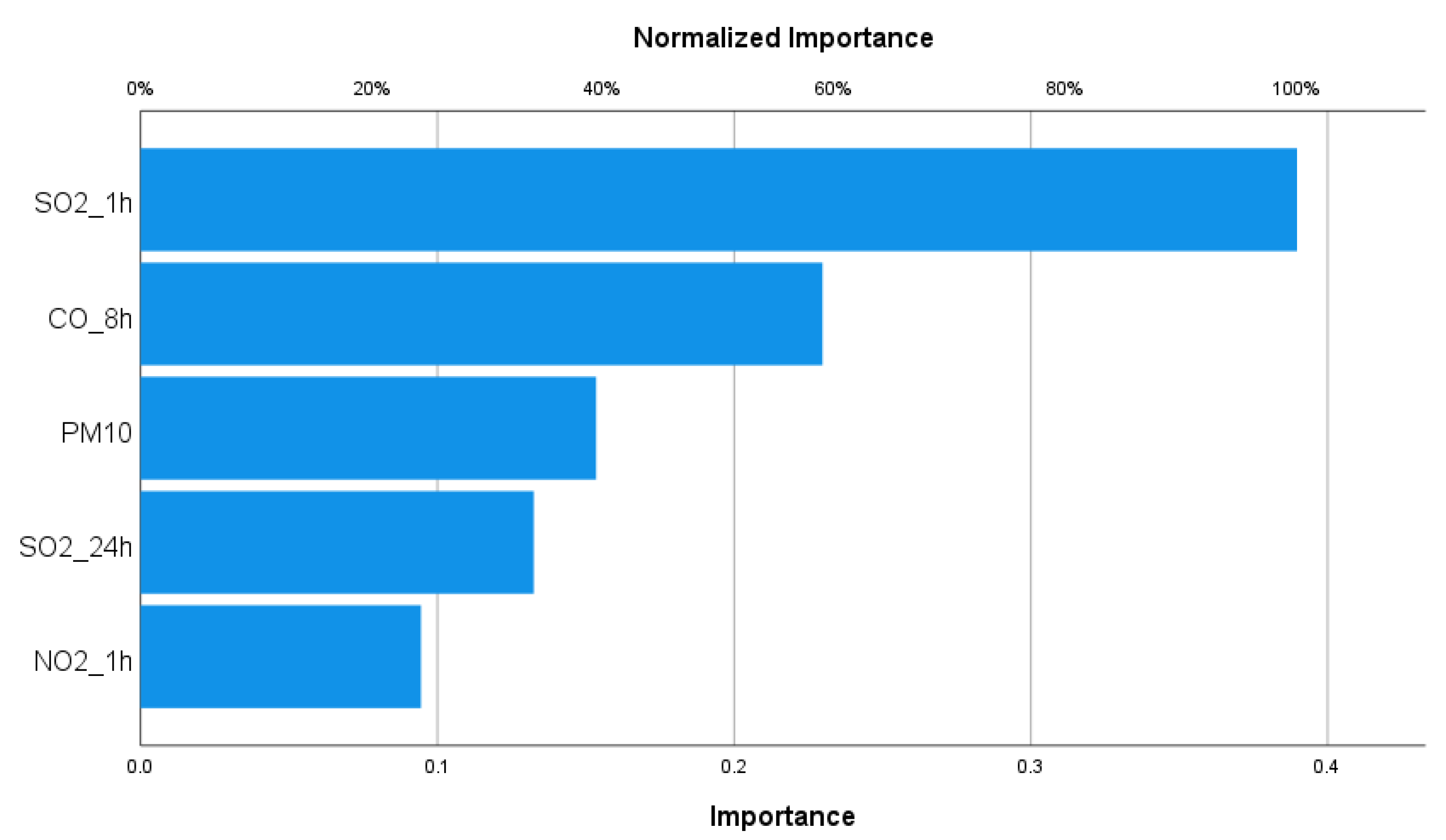
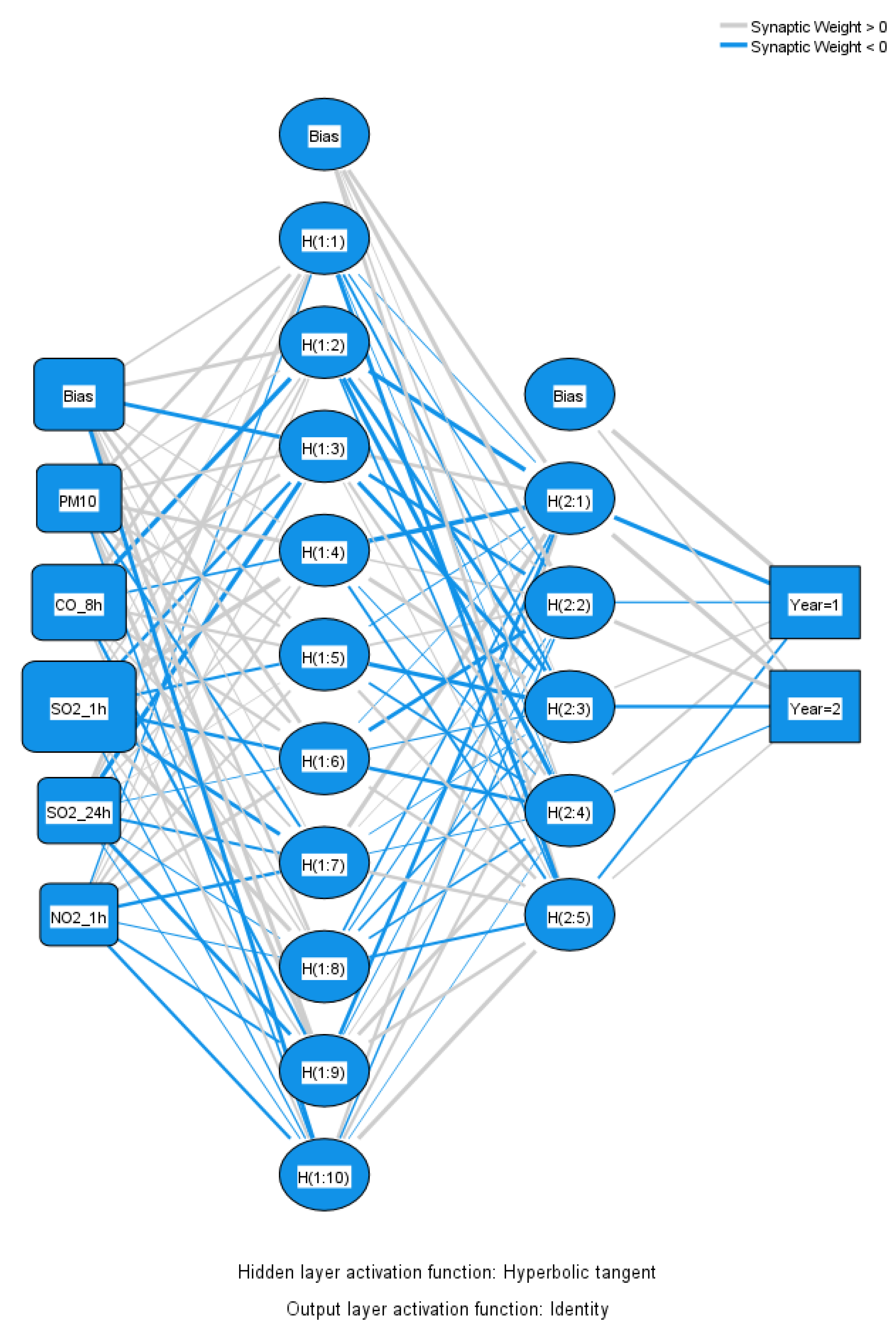
References
- Republic of Lithuania Law on Environmental Protection. Available online: https://e-seimas.lrs.lt/portal/legalAct/lt/TAD/6378f2b0023211e6bf4ee4a6d3cdb874 (accessed on 3 May 2021).
- Review of the National Air Pollution Control Programme. Available online: https://ec.europa.eu/environment/air/pdf/reduction_napcp/NAPCP%20review%20report%20LT%20-%20Final%20updated%2025Jun20.pdf (accessed on 3 May 2021).
- Guarnieri, M.; Balmes, J.R. Outdoor air pollution and asthma. Lancet 2014, 383, 1581–1592. [Google Scholar] [CrossRef]
- Frosina, E.; Romagnuolo, L.; Bonavolontà, A.; Andreozzi, A.; Senatore, A.; Fortunato, F.; Giliberti, P. Evaporative emissions in a fuel tank of vehicles: Numerical and experimental approaches. Energy Procedia 2018, 148, 1167–1174. [Google Scholar] [CrossRef]
- Nieuwenhuijsen, M.J. Urban and transport planning, environmental exposures and health-new concepts, methods and tools to improve health in cities. Environ. Health 2016, 15, 38. [Google Scholar] [CrossRef] [PubMed]
- Bigazzi, A.Y.; Rouleau, M. Can traffic management strategies improve urban air quality? A review of the evidence. J. Transp. Health 2017, 7 Pt B, 111–124. [Google Scholar] [CrossRef]
- Bradley, N.; Dobney, A.; Exley, K.; Stewart-Evans, J.; Aldridge, S.; Craswell, A.; Dimitroulopoulou, S.; Hodgson, G.; Izon-Cooper, L.; Mitchem, L.; et al. Review of Interventions to Improve Outdoor Air Quality and Public Health. 2019. Available online: https://www.gov.uk/government/publications/improving-outdoorair-quality-and-health-review-of-interventions (accessed on 3 May 2021).
- Burns, J.; Boogaard, H.; Polus, S.; Pfadenhauer, L.M.; Rohwer, A.C.; van Erp, A.M.; Turley, R.; Rehfuess, E. Interventions to reduce ambient particulate matter air pollution and their effect on health. Cochrane Database Syst. Rev. 2019, 5, CD010919. [Google Scholar] [CrossRef]
- Conlan, B.; Fraser, A.; Vedrenne, M.; Tate, J.; Whittles, A. Evidence Review on Effectiveness of Transport Measures in Reducing Nitrogen Dioxide: Exploring and Apprasing Proposed Measures to Tackle Air Quality, Department for Environment Food and Rural Affairs. 2016. Available online: https://uk-air.defra.gov.uk/assets/documents/reports/cat05/1605120947_AQ0959_appendix_1-evidence_review_on_air_quality_effects_of_transport_measures.pdf (accessed on 3 May 2021).
- Holman, C.; Harrison, R.; Querol, X. Review of the efficacy of low emission zones to improve urban air quality in European cities. Atmos. Environ. 2015, 111, 161–169. [Google Scholar] [CrossRef]
- Amsterdam Climate Neutral 2050 Roadmap-Phase 1: An Invitation to the City. Available online: http://carbonneutralcities.org/wp-content/uploads/2019/12/Amsterdam-Climate-Neutral-2050-Roadmap_12072019-1.pdf (accessed on 3 May 2021).
- Gurjar, B.R.; Butler, T.M.; Lawrence, M.G.; Lelieveld, J. Evaluation of emissions and air quality in megacities. Atmos. Environ. 2008, 42, 1593–1606. [Google Scholar] [CrossRef]
- Manucci, P.M.; Franchini, M. Health effects of ambient air pollution in developing countries. Int. J. Environ. Res. Public Health 2017, 14, 1048. [Google Scholar] [CrossRef]
- WHO. Air Pollution. Available online: http://www.who.int/airpollution/en/ (accessed on 5 June 2021).
- Ali, M.; Athar, M. Air pollution due to traffic, air quality monitoring along three sections of National Highway N-5, Pakistan. Environ. Monit. Assess. 2008, 136, 219–226. [Google Scholar] [CrossRef]
- Aziz, A.; Bajwa, I.U. Minimizing human health effects of urban air pollution through quantification and control of motor vehicular carbon monoxide (CO) in Lahore. Environ. Monit. Assess. 2007, 135, 459–464. [Google Scholar] [CrossRef]
- Reikard, G. Volcanic emissions and air pollution: Forecasts from time series models. Atmos. Environ. X 2019, 1, 100001. [Google Scholar] [CrossRef]
- Rybarczyk, Y.; Zalakeviciute, R.; Rybarczyk, Y.; Zalakeviciute, R. Machine Learning Approaches for Outdoor Air Quality Modelling: A Systematic Review. Appl. Sci. 2018, 8, 2570. [Google Scholar] [CrossRef]
- Kumar, A.; Goyal, P. Forecasting of air quality in Delhi using principal component regression technique. Atmos. Pollut. Res. 2011, 2, 436–444. [Google Scholar] [CrossRef]
- Donnelly, A.; Misstear, B.; Broderick, B. Real time air quality forecasting using integrated parametric and non-parametric regression techniques. Atmos. Environ. 2015, 103, 53–65. [Google Scholar] [CrossRef]
- Zhu, J.; Wu, P.; Chen, H.; Zhou, L.; Tao, Z.; Zhu, J.; Wu, P.; Chen, H.; Zhou, L.; Tao, Z. A Hybrid Forecasting Approach to Air Quality Time Series Based on Endpoint Condition and Combined Forecasting Model. Int. J. Environ. Res. Public Health 2018, 15, 1941. [Google Scholar] [CrossRef]
- Silibello, C.; D’Allura, A.; Finardi, S.; Bolignano, A.; Sozzi, R. Application of bias adjustment techniques to improve air quality forecasts. Atmos. Pollut. Res. 2015, 6, 928–938. [Google Scholar] [CrossRef]
- Sozzi, R.; Bolignano, A.; Ceradini, S.; Morelli, M.; Petenko, I.; Argentini, S. Quality control and gap-filling of PM10 daily mean concentrations with the best linear unbiased estimator. Environ. Monit. Assess. 2017, 189, 562. [Google Scholar] [CrossRef]
- Bekesiene, S.; Meidute-Kavaliauskiene, I.; Vasiliauskiene, V. Accurate Prediction of Concentration Changes in Ozone as an Air Pollutant by Multiple Linear Regression and Artificial Neural Networks. Mathematics 2021, 9, 356. [Google Scholar] [CrossRef]
- Radojevi´c, D.; Antanasijevi´c, D.; Peri´c-Gruji´c, A.; Risti´c, M.; Pocajt, V. The significance of periodic parameters for ANN modeling of daily SO2 and NOx concentrations: A case study of Belgrade, Serbia. Atmos. Pollut. Res. 2019, 10, 621–628. [Google Scholar] [CrossRef]
- Pawlak, I.; Jarosławski, J.; Pawlak, I.; Jarosławski, J. Forecasting of Surface Ozone Concentration by Using Artificial Neural Networks in Rural and Urban Areas in Central Poland. Atmosphere 2019, 10, 52. [Google Scholar] [CrossRef]
- Biancofiore, F.; Busilacchio, M.; Verdecchia, M.; Tomassetti, B.; Aruffo, E.; Bianco, S.; Di Tommaso, S.; Colangeli, C.; Rosatelli, G.; Di Carlo, P. Recursive neural network model for analysis and forecast of PM10 and PM2.5. Atmos. Pollut. Res. 2017, 8, 652–659. [Google Scholar] [CrossRef]
- James, K.L.; Randall, N.P.; Haddaway, N.R. A methodology for systematic mapping in environmental sciences. Environ. Evid. 2016, 5, 7. [Google Scholar] [CrossRef]
- Samet, J.M.; Dominici, F.; Zeger, S.L.; Schwartz, J.; Dockery, D.W. The National Morbidity, Mortality, and Air Pollution Study. Part I: Methods and methodologic issues. Res. Rep. Health Eff. Inst. 2000, 94, 5–14; discussion 75–84. [Google Scholar] [PubMed]
- Katsouyanni, K.; Touloumi, G.; Samoli, E.; Gryparis, A.; Le Tertre, A.; Monopolis, Y.; Rossi, G.; Zmirou, D.; Ballester, F.; Boumghar, A.; et al. Confounding and effect modification in the short-term effects of ambient particles on total mortality: Results from 29 European cities within the APHEA2 project. Epidemiology 2001, 12, 521–531. [Google Scholar] [CrossRef]
- Dominici, F.; Daniels, M.; Zeger, S.L.; Samet, J.M. Air pollution and mortality: Estimating regional and national dose-response relationships. J. Am. Stat. Assoc. 2002, 97, 100–111. [Google Scholar] [CrossRef]
- Anderson, H.R.; Atkinson, R.W.; Peacock, J.L.; Sweeting, M.J.; Marston, L. Ambient particulate matter and health effects: Publication bias in studies of short-term associations. Epidemiology 2005, 16, 155–163. [Google Scholar] [CrossRef]
- Le Tertre, A.; Medina, S.; Samoli, E.; Forsberg, B.; Michelozzi, P.; Boumghar, A. Short-term effects of particulate air pollution on cardiovascular diseases in eight European cities. J. Epidemiol. Commun. Health 2002, 56, 773–779. [Google Scholar] [CrossRef]
- Zhang, Y.; Ma, Y.; Feng, F.; Cheng, B.; Wang, H.; Shen, J.; Jiao, H. Association between PM10 and specific circulatory system diseases in China. Sci. Rep. 2021, 11, 12129. [Google Scholar] [CrossRef]
- Wu, T.; Ma, Y.; Wu, X.; Bai, M.; Peng, Y.; Cai, W.; Wang, Y.; Zhao, J.; Zhang, Z. Association between particulate matter air pollution and cardiovascular disease mortality in Lanzhou, China. Environ. Sci. Pollut. Res. Int. 2019, 26, 15262–15272. [Google Scholar] [CrossRef]
- El Shawarby, I.; Kyoungho, A.; Hesham, R. Comparative field evaluation of vehicle cruise speed and acceleration level impacts on hot stabilized emissions, Transportation Research Part D. Transp. Environ. 2005, 10, 13–30. [Google Scholar] [CrossRef]
- Lawson, D.R. Passing the Test-Human Behavior and California’s Smog Check Program. J. Air Waste Manag. Assoc. 1993, 43, 1567. [Google Scholar] [CrossRef]
- Kazopoulo, M.; El Fadel, M.; Kaysi, I. Emission standards development for an inspection/maintenance program. J. Environ. Eng. 2005, 131, 1330–1339. [Google Scholar] [CrossRef]
- Levinson, D.M.; Gillen, D.; Kanafani, A. The social costs of intercity transportation: A review and comparison of air and highway. Transp. Rev. 1998, 18, 215–240. [Google Scholar] [CrossRef]
- World Health Organization. World Health Organization, 2018. Global Air Pollution Issue. Available online: https://www.who.int/airpollution/infographics/en/ (accessed on 3 May 2021).
- USEPA. Guidelines for Carcinogen Risk Assessment Review Draft. NCEA-F-0644. July 1999. Available online: http://www.epa.gov/cancerguidelines/draft-guidelines-carcinogen-ra-1999.htm (accessed on 23 January 2021).
- Oak Ridge National Laboratory. Available online: https://www.ornl.gov/sites/default/files/ORNL%20Review%20v33n3%202000.pdf (accessed on 23 January 2021).
- Slovic, A.D.; de Oliveira, M.A.; Biehl, J.; Ribeiro, H. How can urban policies improve air quality and help mitigate global climate change: A systematic mapping review. J. Urban Health 2016, 93, 73–95. [Google Scholar] [CrossRef]
- Stieb, D.M.; Judek, S.; Burnett, R.T. Meta-analysis of time-series studies of air pollution and mortality: Update in relation to the use of generalized additive models. J. Air Waste Manag. Assoc. 2003, 53, 258–261. [Google Scholar] [CrossRef]
- Berkey, C.S.; Hoaglin, D.C.; Mosteller, F.; Colditz, G.A. A random-effects regression model for meta-analysis. Stat. Med. 1995, 14, 395–411. [Google Scholar] [CrossRef]
- Mohan, Y.; Chee, S.S.; Xin, D.K.P.; Foong, L.P. Artificial Neural Network for Classification of Depressive and Normal in EEG. In Proceedings of the IEEE-EMBS Conference on Biomedical Engineering and Sciences (IECBES 2016), Kuala Lumpur, Malaysia, 5–7 December 2016; Institute of Electrical and Electronics Engineers Inc.: Piscataway, NJ, USA, 2016; pp. 286–290. [Google Scholar]
- Lewis, F.L.; Huang, J.; Parisini, T.; Prokhorov, D.V.; Wunsch, D.C. Guest Editorial: Special Issue on Neural Networks for Feedback Control Systems. IEEE Trans. Neural Netw. 2007, 18, 969–972. [Google Scholar] [CrossRef]
- Norgaard, M.; Ravn, O.; Poulsen, N.K.; Hansen, L.K. Neural Networks for Modelling and Control of Dynamic Systems—A Practitioner’s Handbook; Springer: London, UK, 2000; ISBN 978-1-85233-227-3. [Google Scholar]
- Ludermir, T.B.; Yamazaki, A.; Zanchettin, C. An Optimization Methodology for Neural Network Weights and Architectures. IEEE Trans. Neural Netw. 2006, 17, 1452–1459. [Google Scholar] [CrossRef]
- Malinova, T.; Guo, Z.X. Artificial Neural Network Modelling of Hydrogen Storage Properties of Mg-Based Alloys. Mater. Sci. Eng. A 2004, 365, 219–227. [Google Scholar] [CrossRef]
- Song, R.-G.; Zhang, Q.-Z.; Tseng, M.-K.; Zhang, B.-J. The Application of Artificial Neural Networks to the Investigation of Aging Dynamics in 7175 Aluminium Alloys. Mater. Sci. Eng. C 1995, 3, 39–41. [Google Scholar] [CrossRef]
- Baughman, D.R.; Liu, Y.A. Fundamental and Practical Aspects of Neural Computing. In Neural Networks in Bioprocessing and Chemical Engineering; Elsevier: Amsterdam, The Netherlands, 1995. [Google Scholar]
- Trenn, S. Multilayer Perceptrons: Approximation Order and Necessary Number of Hidden Units. IEEE Trans. Neural Netw. 2008, 19, 836–844. [Google Scholar] [CrossRef] [PubMed]
- ROC Curve. Available online: https://www.ibm.com/support/knowledgecenter/en/SSLVMB_23.0.0/spss/tutorials/mlp_bankloan_roc-curve_02.html (accessed on 17 February 2021).
- Paschalidou, A.K.; Karakitsios, S.; Kleanthous, S.; Kassomenos, P.A. Forecasting hourly PM10 concentration in Cyprus through artificial neural networks and multiple regression models: Implications to local environmental management. Environ. Sci. Pollut. Res. 2011, 18, 316–327. [Google Scholar] [CrossRef] [PubMed]
- Antanasijević, D.Z.; Ristić, M.Đ.; Perić-Grujić, A.A.; Pocajt, V.V. Forecasting human exposure to PM10 at the national level using an artificial neural network approach. J. Chemom. 2013, 27, 170–177. [Google Scholar] [CrossRef]
- Cohen, J. Statistical Power Analysis for the Behavioral Sciences, 2nd ed.; Lawrence Erlbaum Associates Publishers: New York, NY, USA, 1988; Available online: http://www.utstat.toronto.edu/~{}brunner/oldclass/378f16/readings/CohenPower.pdf (accessed on 10 February 2021).
- Lakens, D. Calculating and reporting effect sizes to facilitate cumulative science: A practical primer for t-tests and ANOVAs. Front. Psychol. 2013, 4, 863. [Google Scholar] [CrossRef] [PubMed]
- Parsimehr, M.; Shayesteh, K.; Godini, K.; Bayat Varkeshi, M. Using multilayer perceptron artificial neural network for predicting and modeling the chemical oxygen demand of the Gamasiab River. Avicenna J. Environ. Health Eng. 2018, 5, 15–20. [Google Scholar] [CrossRef]
- Malik, A.; Kumar, A.; Kisi, O. Monthly panevaporation estimation in Indian central Himalayas using different heuristic approaches and climate-based models. Comput. Electron. Agric. 2017, 143, 302–313. [Google Scholar] [CrossRef]
- Li, C.; Liang, M.; Wang, T. Criterion fusion for spectral segmentation and its application to optimal demodulation of bearing vibration signals. Mech. Syst. Signal Process. 2015, 64–65, 132–148. [Google Scholar] [CrossRef]
- Mohebbi, M.R.; Jashni, A.K.; Dehghani, M.; Hadad, K. Short-Term prediction of carbon monoxide concentration using artificial neural network (NARX) without traffic data: Case study: Shiraz City. Iran. J. Sci. Technol. Trans. Civ. Eng. 2019, 43, 533–540. [Google Scholar] [CrossRef]
- Ostad-Ali-Askari, K.; Shayannejad, M.; Ghorbanizadeh-Kharazi, H. Artificial neural network for modeling nitrate pollution of groundwater in marginal area of Zayandehrood River, Isfahan, Iran. KSCE J. Civ. Eng. 2017, 21, 134–140. [Google Scholar] [CrossRef]
- Javed, W.; Wexler, A.S.; Murtaza, G.; Iqbal, M.M.; Zhao, Y.; Naz, T. Chemical characterization and source apportionment of atmospheric particles across multiple sampling locations in Faisalabad, Pakistan. Clean Soil Air Water 2016, 44, 753–765. [Google Scholar] [CrossRef]
- Huang, X.H.; Bian, Q.J.; Louie, P.K.K.; Yu, J.Z. Contributions of vehicular carbonaceous aerosols to PM2.5 in a roadside environment in Hong Kong. Atmos. Chem. Phys. 2014, 14, 9279–9293. [Google Scholar] [CrossRef]
- Aslam, A.; Ibrahim, M.; Shahid, I.; Mahmood, A.; Irshad, M.K.; Yamin, M.; Ghazala, M.; Shamshiri, R.R. Pollution Characteristics of Particulate Matter (PM2.5 and PM10) and Constituent Carbonaceous Aerosols in a South Asian Future Megacity. Appl. Sci. 2020, 10, 8864. [Google Scholar] [CrossRef]
- Shahid, I.; Kistler, M.; Mukhtar, A.; Ghauri, B.M.; Cruz, C.R.S.; Bauer, H.; Puxbaum, H. Chemical characterization and mass closure of PM10 and PM2.5 at an urban site in Karachi, Pakistan. Atmos. Environ. 2016, 128, 114–123. [Google Scholar] [CrossRef]
- Niaz, Y.; Zhou, J.; Iqbal, M.; Nasir, A.; Dong, B. Ambient air quality evaluation: A comparative study in China and Pakistan. Pol. J. Environ. Stud. 2015, 24, 1723–1732. [Google Scholar] [CrossRef]
- Weinhold, B. Global bang for the buck: Cutting black carbon and methane benefits both health and climate. Environ. Health Perspect. 2012, 120, A245. [Google Scholar] [CrossRef][Green Version]
- Nigam, S.; Rao, B.P.S.; Kumar, N.; Mhaisalkar, V.A. Air quality index-A comparative study for assessing the status of air quality. Res. J. Eng. Technol. 2015, 6, 267–274. [Google Scholar] [CrossRef]
- Seinfeld, J.H.; Pandis, S.N. Atmospheric Chemistry and Physics: From Air Pollution to Climate Change; John Wiley & Sons: Hoboken, NJ, USA, 2016. [Google Scholar]
- Stansfeld, S.A. Noise effects on health in the context of air pollution exposure. Int. J. Environ. Res. Public Health 2015, 12, 12735–12760. [Google Scholar] [CrossRef]
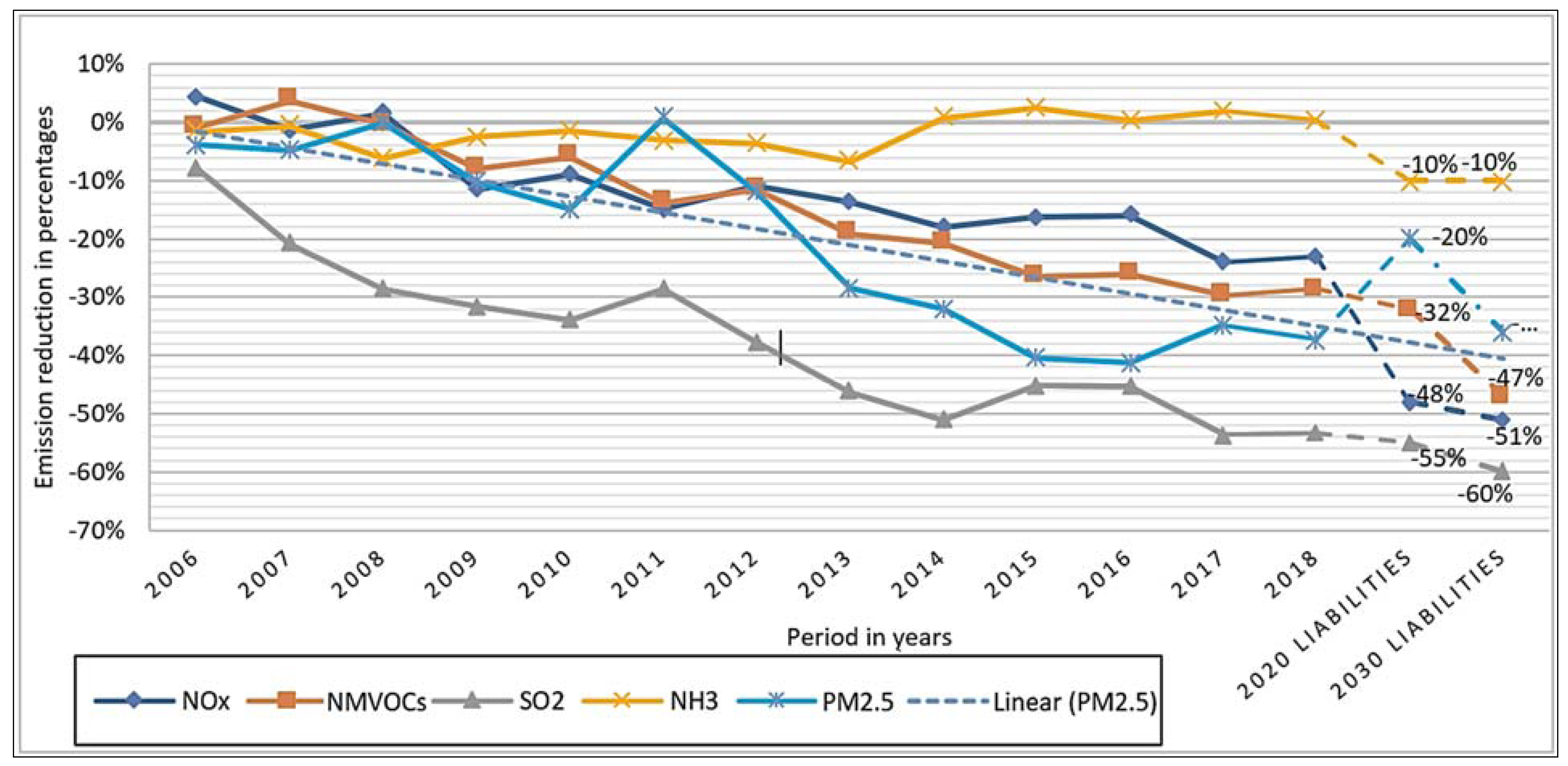



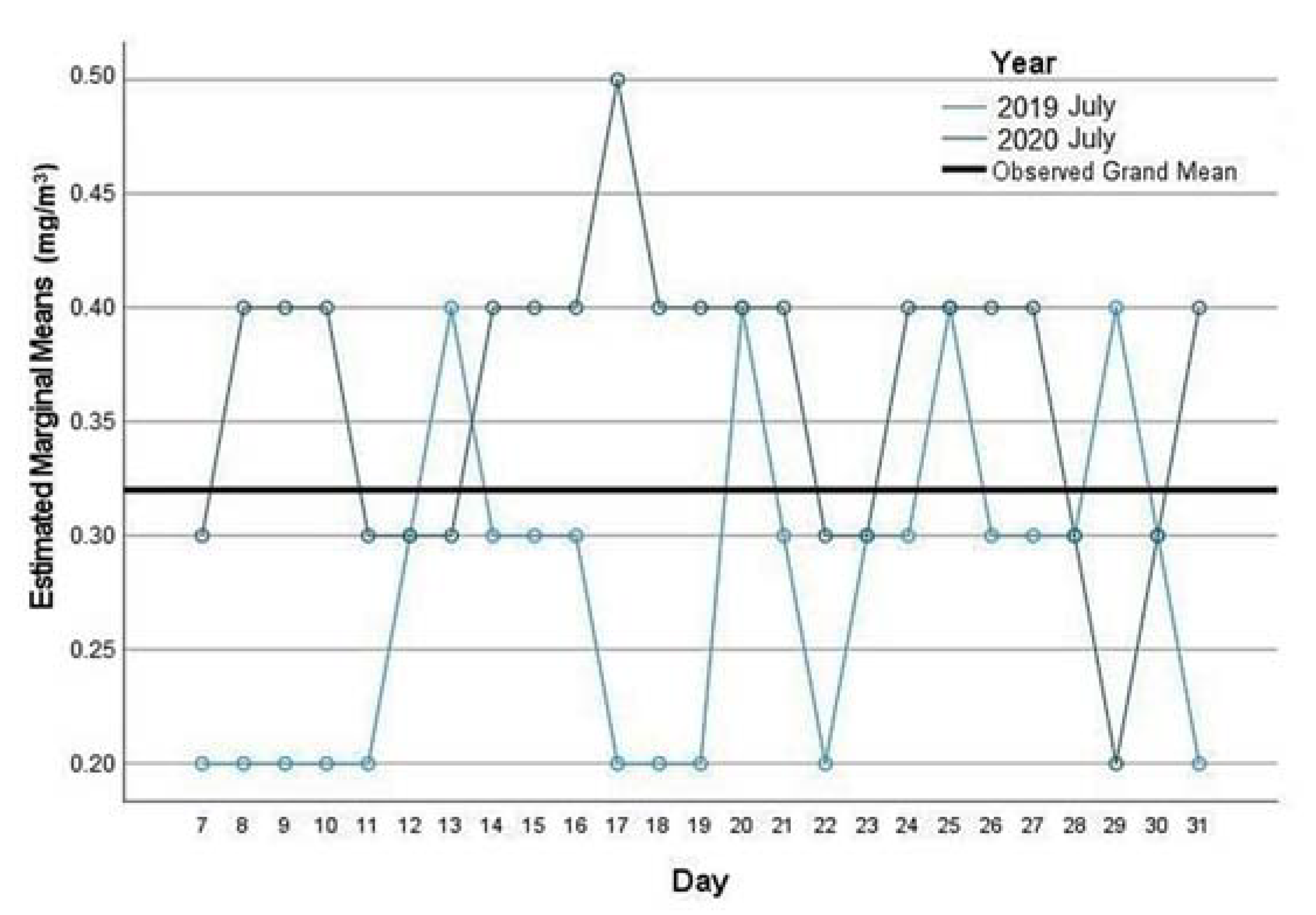
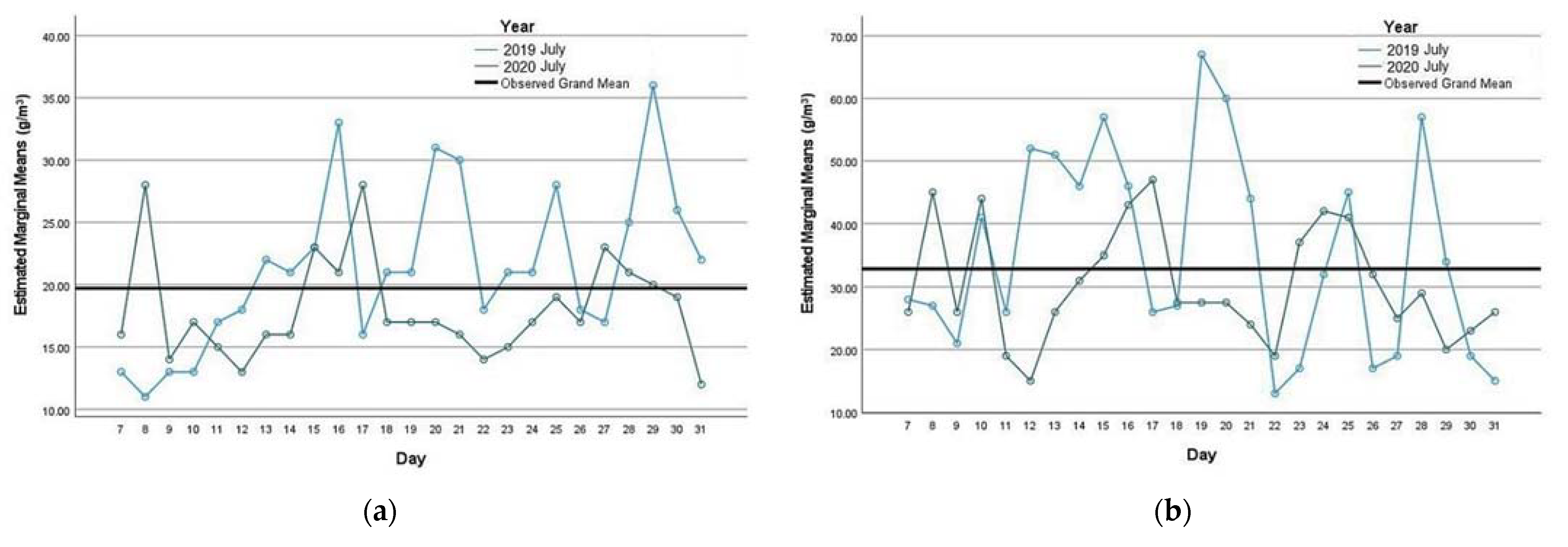
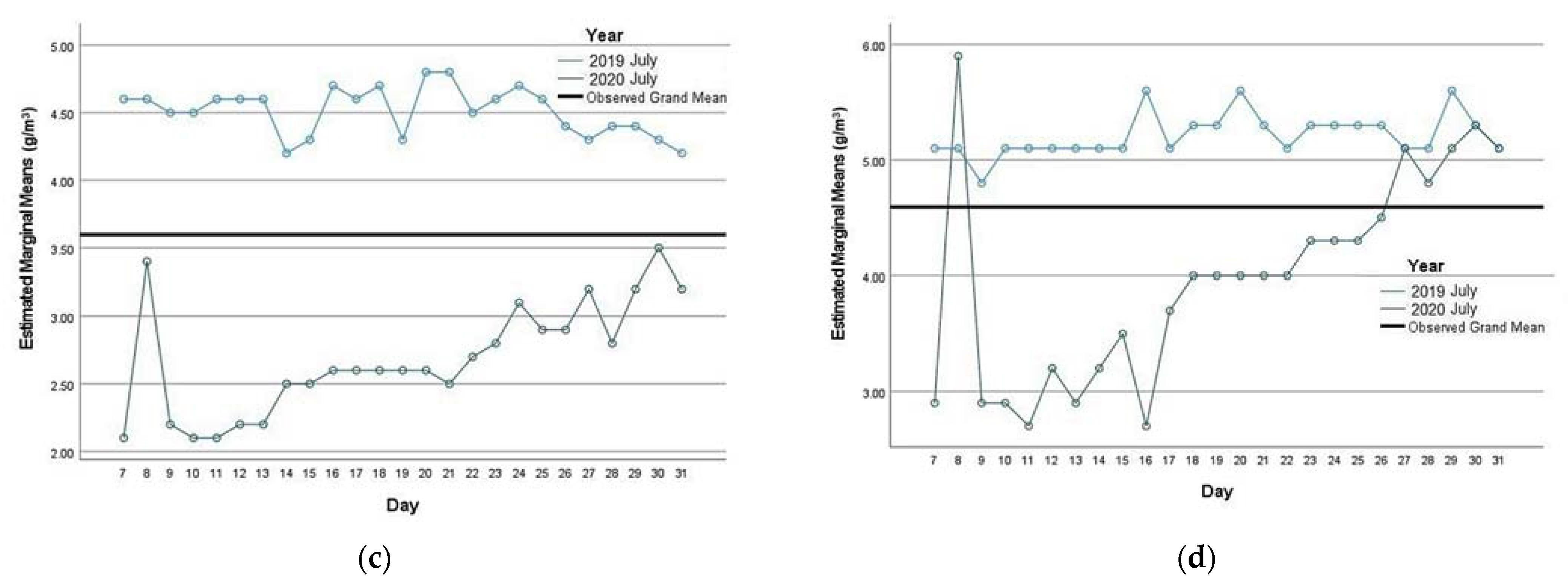
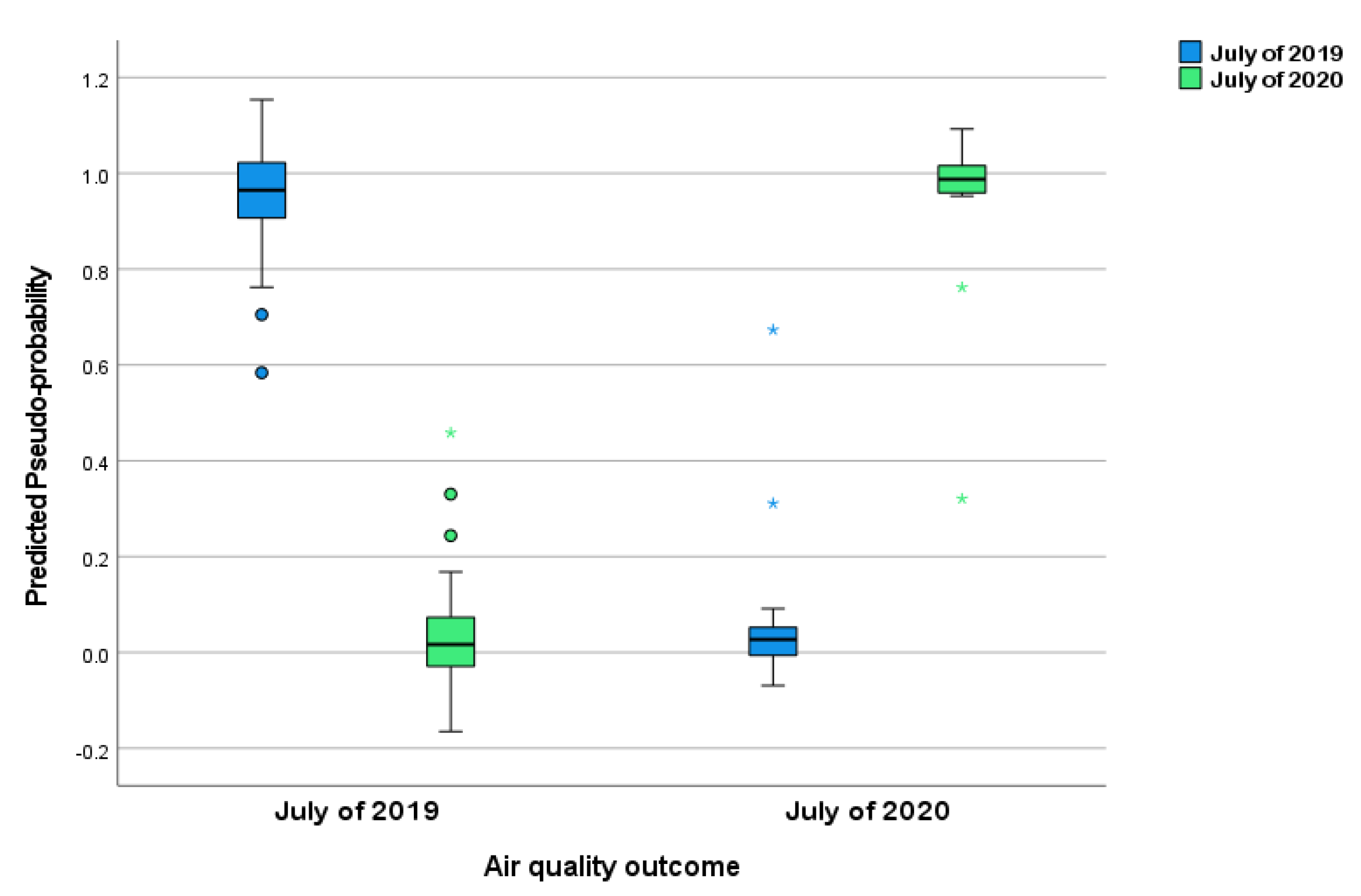
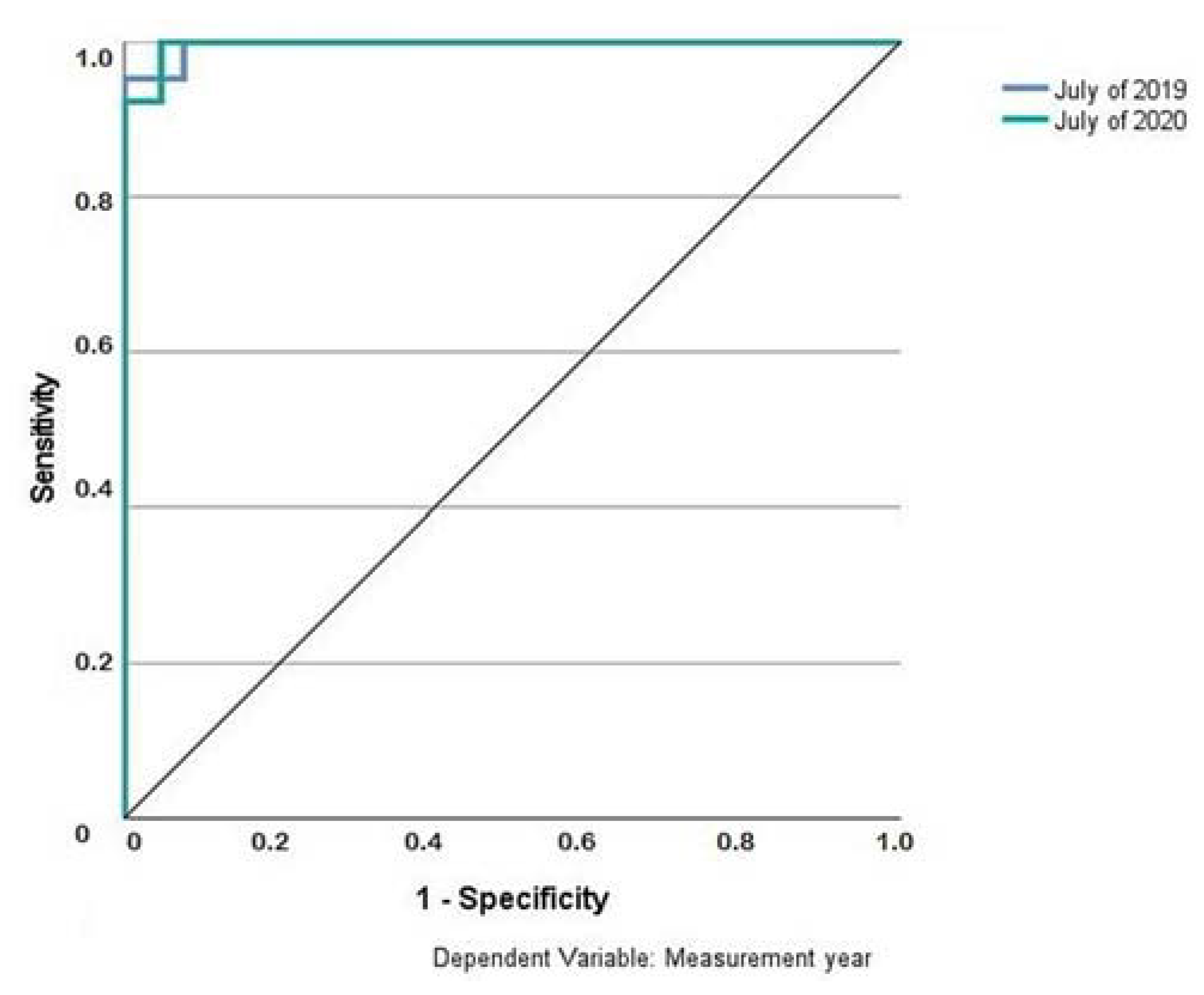
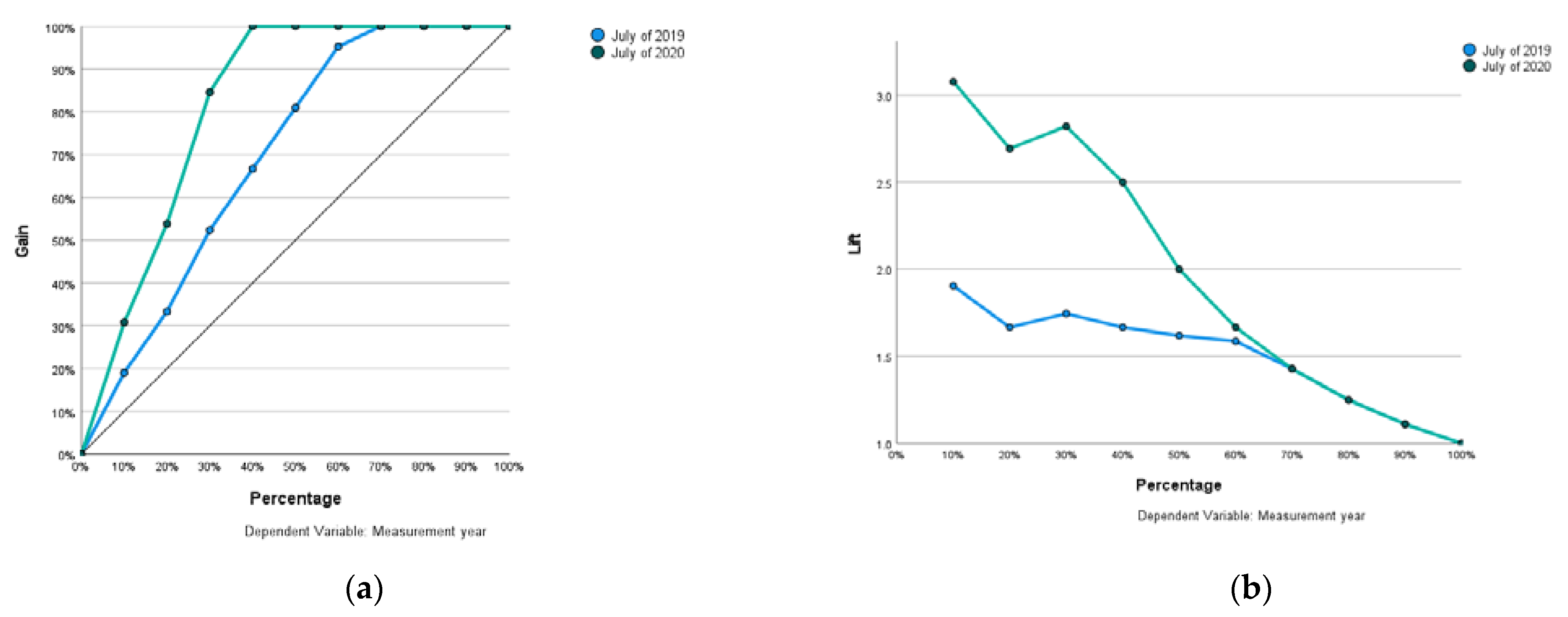
| Air Pollution Characteristics | Pollutants | Influence |
|---|---|---|
| Photochemical smog | Tailpipe emissions from automobiles. Ozone (O3), by reaction between Volatile Organic Compounds (VOCs), and Nitrogen Oxides (NOx) and water in the presence of sunlight. | Health, vegetation and material damages. |
| Acid Rain | Sulphur Dioxide (SO2) and Nitrogen Dioxide (NO2) react with H2O to form sulphuric and nitric acid. | Health, vegetation and material damages. |
| Stratospheric ozone | Chlorofluorocarbons (CFCs) | More intense ultraviolet radiation towards the earth. |
| Greenhouse Effect | Man-made pollutants including Carbon Dioxide (CO2), Methane (CH4), Nitrous Oxide (N2O), O3, and CFCs | Raising the average temperature on Earth, resulting in slight melting of polar ice-caps and a consequent rise in the sea level. |
| Pollutant | Description | Impact |
|---|---|---|
| Carbon dioxide (CO2) | A by-product of combustion. | Fuel production and engines. |
| Carbon monoxide (CO) | A toxic gas which undermines blood’s ability to carry oxygen. | Fuel production and engines. |
| CFCs | Durable chemical harmful to the ozone layer and climate. | Older air conditioners, aerosol. |
| Fine particulates (PM10; PM2.5) | Inhalable particles consisting of bits of fuel and carbon. | Diesel engines and other sources. |
| Hydrocarbons (HC) | Unburned fuel. Forms ozone. | Fuel production and engines. |
| Lead | Element used in older fuel additives. | Fuel additives and batteries. |
| Methane (CH4) | A gas with significant greenhouse gas properties. | Fuel production and engines. |
| Nitrogen oxides (NOx) | Various compounds. | Some are toxic, and all contribute to ozone. |
| Ozone (O3) | Major urban air pollution problem resulting from NOx and VOCs combined in sunlight. | NOx and VOC. |
| Road dust | Dust particles created by vehicle movement. | Vehicle use. |
| Sulphur Oxide (SOx) | Lung irritant, causes acid rain. | Diesel engines. |
| Volatile organic hydrocarbons (VOCs). | A variety of organic compounds that form aerosols. | Fuel production and engines. |
| Toxics (e.g., benzene) | VOCs that are toxic and carcinogenic. | Fuel production and engines. |
| Pollutant | 7–31 July 2019 | 7–31 July 2020 | Paired Mean Differences | Cohen’s d (Rating) | ||
|---|---|---|---|---|---|---|
| Mean | Std. Deviation | Mean | Std. Deviation | |||
| PM10 (g/m3) | 21.400 | 6.513 | 18.040 | 4.118 | 3.36 * | 0.434 (small) |
| 3 CO (mg/m3) | 0.276 | 0.072 | 0.364 | 0.064 | −0.09 ** | 0.806 (large) |
| 1 SO2_1 h (g/m3) | 4.512 | 0.176 | 2.684 | 0.415 | 1.83 ** | 3.665 (large) |
| 2 SO2_24 h (g/m3) | 5.212 | 0.188 | 3.972 | 0.912 | 1.24 ** | 1.391 (large) |
| NO2 (g/m3) | 35.480 | 16.078 | 30.300 | 9.086 | 5.18 | 0.287 (small) |
| Layer | Partitions | Number of Units | Activation Function | 1 Variable Description |
|---|---|---|---|---|
| MLPN1:4-4-2 | ||||
| Input | 28.0% | 5 | - | IV: PM10, CO, SO2_1 h, SO2_24 h, NO2 |
| Hidden (1) | 40.0% | 10 | Hyperbolic tangent | |
| Hidden (2) | 5 | |||
| Output | 30.0% | 2 | Identity | DV: (SIT: 1 = July 2019; 2 = July 2020) |
| MLPN2: 5-3-2 | ||||
| Input | 44.0% | 5 | - | IV: PM10, CO, SO2_1h, SO2_24 h, NO2 |
| Hidden (1) | 34.0% | 10 | Hyperbolic tangent | |
| Hidden (2) | 5 | |||
| Output | 22.0% | 2 | Identity | DV: (SIT: 1 = July 2019; 2 = July 2020) |
| MLPN3: 6-2-2 | ||||
| Input | 60.0% | 5 | - | IV: PM10, CO, SO2_1 h, SO2_24 h, NO2 |
| Hidden (1) | 20.0% | 10 | Hyperbolic tangent | |
| Hidden (2) | 5 | |||
| Output | 20.0% | 2 | Identity | DV: (SIT: 1 = July 2019; 2 = July 2020) |
| Layer Description | MLPN1 4-4-2 | MLPN2 5-3-2 | MLPN3 6-2-2 | |
|---|---|---|---|---|
| 1 Training | Sum of Squares Error | 0.005 | 0.008 | 0.411 |
| Percent Incorrect Predictions | 0.0% | 0.0% | 0.0% | |
| Training Time | 0:00:00.01 | 0:00:00.01 | 0:00:00.01 | |
| Testing | Sum of Squares Error | 0.021 | 0.057 | 0.075 |
| Percent Incorrect Predictions | 0.0% | 0.0% | 0.0% | |
| Holdout | Percent Incorrect Predictions | 0.0% | 33.3% | 0.0% |
| Sample | Observed | 1 Predicted Dependent Variable | ||||||||
|---|---|---|---|---|---|---|---|---|---|---|
| MLPN1 (4-4-2) | MLPN2 (5-3-2) | MLPN3 (6-2-2) | ||||||||
| SIT1 | SIT2 | Percent Correct | SIT1 | SIT2 | Percent Correct | SIT1 | SIT2 | Percent Correct | ||
| Training | July 2019 | 10 | 0 | 100.0% | 10 | 0 | 100.0% | 15 | 0 | 100.0% |
| July 2020 | 0 | 10 | 100.0% | 0 | 13 | 100.0% | 0 | 15 | 100.0% | |
| Overall Percent | 50.0% | 50.0% | 100.0% | 43.5% | 56.5% | 100.0% | 50.0% | 50.0% | 100.0% | |
| Testing | July 2019 | 10 | 0 | 100.0% | 13 | 0 | 100.0% | 5 | 0 | 100.0% |
| July 2020 | 0 | 10 | 100.0% | 0 | 5 | 100.0% | 0 | 5 | 100.0% | |
| Overall Percent | 50.0% | 50.0% | 100.0% | 72.2% | 27.8% | 100.0% | 50.0% | 50.0% | 100.0% | |
| Holdout | July 2019 | 5 | 0 | 100.0% | 2 | 0 | 100.0% | 5 | 0 | 100.0% |
| July 2020 | 0 | 5 | 100.0% | 3 | 4 | 57.1% | 0 | 5 | 100.0% | |
| Overall Percent | 50.0% | 50.0% | 100.0% | 55.6% | 44.4% | 66.7% | 50.0% | 50.0% | 100.0% | |
| MLPN1 40%-40%-20% | MLPN2 50%-30%-20% | MLPN3 60%-20%-20% | ||
|---|---|---|---|---|
| Area | Area | Area | ||
| 1 SIT | SIT1 = July 2019 | 0.998 | 1.000 | 1.000 |
| SIT2 = July 2020 | 1.000 | 1.000 | 1.000 | |
| 1 Variables | MLPN1 40%-40%-20% | MLPN2 50%-30%-20% | MLPN3 60%-20%-20% | |||
|---|---|---|---|---|---|---|
| Importance | Normalized Importance | Importance | Normalized Importance | Importance | Normalized Importance | |
| PM10 | 0.154 | 39.4% | 0.033 | 5.9% | 0.116 | 21.8% |
| CO | 0.230 | 59.0% | 0.259 | 46.6% | 0.180 | 33.8% |
| SO2_1 h | 0.390 | 100.0% | 0.557 | 100.0% | 0.533 | 100.0% |
| SO2_24 h | 0.132 | 34.0% | 0.118 | 21.1% | 0.139 | 26.1% |
| NO2 | 0.094 | 24.2% | 0.034 | 6.0% | 0.031 | 5.8% |
Publisher’s Note: MDPI stays neutral with regard to jurisdictional claims in published maps and institutional affiliations. |
© 2022 by the authors. Licensee MDPI, Basel, Switzerland. This article is an open access article distributed under the terms and conditions of the Creative Commons Attribution (CC BY) license (https://creativecommons.org/licenses/by/4.0/).
Share and Cite
Bekesiene, S.; Meidute-Kavaliauskiene, I. Artificial Neural Networks for Modelling and Predicting Urban Air Pollutants: Case of Lithuania. Sustainability 2022, 14, 2470. https://doi.org/10.3390/su14042470
Bekesiene S, Meidute-Kavaliauskiene I. Artificial Neural Networks for Modelling and Predicting Urban Air Pollutants: Case of Lithuania. Sustainability. 2022; 14(4):2470. https://doi.org/10.3390/su14042470
Chicago/Turabian StyleBekesiene, Svajone, and Ieva Meidute-Kavaliauskiene. 2022. "Artificial Neural Networks for Modelling and Predicting Urban Air Pollutants: Case of Lithuania" Sustainability 14, no. 4: 2470. https://doi.org/10.3390/su14042470
APA StyleBekesiene, S., & Meidute-Kavaliauskiene, I. (2022). Artificial Neural Networks for Modelling and Predicting Urban Air Pollutants: Case of Lithuania. Sustainability, 14(4), 2470. https://doi.org/10.3390/su14042470







